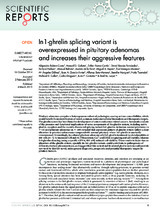Mostrar el registro sencillo del ítem
In1-ghrelin splicing variant is overexpressed in pituitary adenomas and increases their aggressive features
| dc.contributor.author | Ibáñez-Costa, Alejandro | |
| dc.contributor.author | Gahete Ortiz, Manuel D. | |
| dc.contributor.author | Rivero-Cortés, Esther | |
| dc.contributor.author | Rincón-Fernández, David | |
| dc.contributor.author | Nelson, Richard | |
| dc.contributor.author | Beltrán, Manuel | |
| dc.contributor.author | Riva, Andrés de la | |
| dc.contributor.author | Japón, Miguel A. | |
| dc.contributor.author | Venegas-Moreno, Eva | |
| dc.contributor.author | García-Arnés, Juan A. | |
| dc.contributor.author | Soto-Moreno, Alfonso | |
| dc.contributor.author | Morgan, Jennifer | |
| dc.contributor.author | Tsomaia, Natia | |
| dc.contributor.author | Culler, Michael D. | |
| dc.contributor.author | Diéguez, Carlos | |
| dc.contributor.author | Castaño, Justo P. | |
| dc.contributor.author | Luque, Raúl M. | |
| dc.contributor.author | Gálvez-Moreno, M. Ángeles | es_ES |
| dc.date.accessioned | 2018-10-17T09:59:31Z | |
| dc.date.available | 2018-10-17T09:59:31Z | |
| dc.date.issued | 2015 | |
| dc.identifier.uri | http://hdl.handle.net/10396/17305 | |
| dc.description.abstract | Pituitary adenomas comprise a heterogeneous subset of pathologies causing serious comorbidities, which would benefit from identification of novel, common molecular/cellular biomarkers and therapeutic targets. The ghrelin system has been linked to development of certain endocrine-related cancers. Systematic analysis of the presence and functional implications of some components of the ghrelin system, including native ghrelin, receptors and the recently discovered splicing variant In1-ghrelin, in human normal pituitaries (n 5 11) and pituitary adenomas (n 5 169) revealed that expression pattern of ghrelin system suffers a clear alteration in pituitary adenomasas comparedwith normal pituitary, where In1-ghrelin is markedly overexpressed. Interestingly, in cultured pituitary adenoma cells In1-ghrelin treatment (acylated peptides at 100 nM; 24–72 h) increasedGHandACTHsecretion, Ca21 and ERK1/2 signaling and cell viability, whereas In1-ghrelin silencing (using a specific siRNA; 100 nM) reduced cell viability. These results indicate that an alteration of the ghrelin system, specially its In1-ghrelin variant, could contribute to pathogenesis of different pituitary adenomas types, and suggest that this variant and its related ghrelin system could provide new tools to identify novel, more general diagnostic, prognostic and potential therapeutic targets in pituitary tumors. | es_ES |
| dc.format.mimetype | application/pdf | es_ES |
| dc.language.iso | eng | es_ES |
| dc.publisher | Nature.com | es_ES |
| dc.rights | https://creativecommons.org/licenses/by-nc-nd/4.0/ | es_ES |
| dc.source | Scientific Reports 5:8714 (2015) | es_ES |
| dc.subject | Cell biology | es_ES |
| dc.subject | Pituitary tumors | es_ES |
| dc.title | In1-ghrelin splicing variant is overexpressed in pituitary adenomas and increases their aggressive features | es_ES |
| dc.type | info:eu-repo/semantics/article | es_ES |
| dc.relation.publisherversion | http://dx.doi.org/10.1038/srep08714 | es_ES |
| dc.relation.projectID | Junta de Andalucía. CTS-1406 | es_ES |
| dc.relation.projectID | Junta de Andalucía. BIO- 0139 | es_ES |
| dc.relation.projectID | Gobierno de España. PI-0639-2012 | es_ES |
| dc.relation.projectID | Gobierno de España. BFU2013-43282 | es_ES |
| dc.relation.projectID | Gobierno de España. PI13/00651 | es_ES |
| dc.relation.projectID | Junta de Andalucía. CTS-5051 | es_ES |
| dc.relation.projectID | Gobierno de España. CD11/00276 | es_ES |
| dc.relation.projectID | Gobierno de España. CIBER | es_ES |
| dc.rights.accessRights | info:eu-repo/semantics/openAccess | es_ES |

